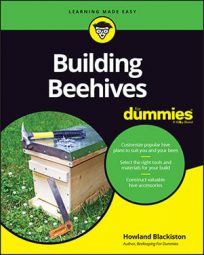Clear off your workbench: It’s time to assemble all the pieces of your frame jig, which holds all the parts to assemble and nail ten bee hive frames at a time.
Attach the long sides to the short sides.
Align the ends of the long sides with the edges of the short sides. Use the deck screws and your power drill with a #2 Phillips head bit to attach the long sides to the edges of the short sides. These are butt joints. Use two screws per corner.
The screws will go in easier if you first drill a 7/64-inch hole in each spot you plan to place a screw. The pre-drilling also helps prevent the wood from splitting.
Throughout this process, consider using wood glue in addition to the screws. It helps make the jig as strong as possible. Apply a thin coat of glue wherever the wooden parts are permanently joined together.
Nail the spacer cleats onto the frame retaining panels.
Using the 1-1/8 inch flat-head, diamond-point wire nails and a hammer, attach a spacer cleat to each end of the frame retaining panels. The spacer cleats should be flush with the outer edges of the panels. Use two nails per cleat and drive them through the cleat and into the retaining panel. Precise placement of nails is not critical.
Attach the toggle latches and catch strikes.
Attach the catch strike of the toggle latch assembly to the edge of each of the retaining panels (the hardware typically comes with the required screw fasteners; use a screwdriver that’s appropriate for the fasteners). Center top to bottom.
Now attach the corresponding toggle latch to the edge of the frame jig assembly using the screw fasteners that come with the latch assembly. Carefully align this toggle latch hardware and position it so you get a tight grip when the latch is engaged with the catch strike.
Aligning the placement of the four toggle latches in a mathematically identical position on all four corners is nearly impossible.
So after you attach the hardware, use a permanent marker to number the toggle latches and the corresponding catch strikes so that when you reassemble the elements, the latches pair up with their counterpart (the number 2 toggle latch matches up with the number 2 catch strike, the number 3 toggle latch matches up with the number 3 catch strike, and so on).
Connect the retainer panels with the rest of the frame jig.
Fasten the retainer panels to the jig assembly using the toggle latch hardware.
You’re now ready to become a frame-making machine! Just follow these steps to use your jig:
Insert 10 side bars into each of the channels created by the frame retaining bars (20 total).
The wide end of the side bar should be facing up.
Snap the top bars into the slot at the wide end of each pair of side bars and secure the top bars in place using two nails at each end.
In addition to nailing, you can also use a little wood glue.
Turn the whole jig over (upside down) so that the top bars are now resting on the work surface.
Insert the bottom bars into the slot at the narrow end of the side bars and secure the bottom bars using a nail at each end.
Open the toggle latches and remove the retainer panels so you can slide the frames free of the jig.
Now isn’t that easier than assembling frames one at a time?
![[Credit: Illustration by Felix Freudzon, Freudzon Design]](https://www.dummies.com/wp-content/uploads/357012.image0.jpg)

